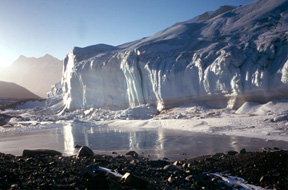 The North and
South Poles were dubbed “climatic bellwethers” when scientists first began
studying global trends. Most climate models predict that if global temperatures
are going to change, the change will be noticed first at the poles. The
models show amplified warming, as has been observed in Arctic regions and parts
of Antarctica over the last half of the 20th century. Scientists are keenly
aware of the importance Antarctica plays in climate studies and have been diligently
watching for any changes or trends.
The North and
South Poles were dubbed “climatic bellwethers” when scientists first began
studying global trends. Most climate models predict that if global temperatures
are going to change, the change will be noticed first at the poles. The
models show amplified warming, as has been observed in Arctic regions and parts
of Antarctica over the last half of the 20th century. Scientists are keenly
aware of the importance Antarctica plays in climate studies and have been diligently
watching for any changes or trends. The Canada Glacier in Antarctica's Wright Valley, one of the the Dry Valleys on McMurdo Sound. Courtesy of Peter Dorn, NSF.
Recently, over the course of two weeks, three seemingly contradictory reports were published. One says that indeed, the frozen frontier is warming; another says that the continent is actually cooling; and the third says an ice sheet is thickening rather than melting. So what is the real story?
First and foremost, it is important to note that all of the articles and the scientists involved agree on one thing: “We’re not saying anything close to ‘the Earth’s climate is not warming,’” as an animated Peter Doran of the University of Illinois at Chicago says.
The second important conclusion they all draw: Much more research is needed. Whatever the length of time each scientist has been studying Antarctica, it pales in comparison to the length of time needed to draw any universal conclusions.
As reported in the Jan. 25 Science, Wendy Quayle and Lloyd Peck of the British Antarctic Survey led a team that has been measuring the decline in summer ice cover on freshwater lakes on Signey Island near the Antarctic Peninsula. The lakes, frozen solid through the harsh Antarctic winter, have warmed significantly, dramatically altering the ecosystem. The lakes are ice free for an average of 31 days per year longer compared with fifteen years ago. Over the past 20 years, the air temperature has increased by nearly 2 degrees Fahrenheit on the island.
Working on the other side of the continent, Peter Doran led researchers with the National Science Foundation’s Long Term Ecological Research (LTER) team studying temperature changes and subsequent effects on the ecosystem in the Dry Valleys near McMurdo Sound, as reported in the online January Nature.
“We found that over the past 35 years, more of the continent has been cooling than warming, and the cooling has been about 1 degree Fahrenheit decrease per decade in the Dry Valleys since 1986,” Doran says. He insists Quayle and Peck’s findings do not contradict his study; his study shows that while the Dry Valleys are cooling much faster than the rest of the continent, areas such as the Antarctic Peninsula are warming faster. The LTER scientists’ analysis indicates that overall, 58 percent of the continent is cooling.
To the west of McMurdo Sound lies the West Antarctic Ice Sheet, which has been retreating during this entire interglacial period. As Ian Joughin of NASA’s Jet Propulsion Laboratory and Slawek Tulaczyk of the University of California at Santa Cruz write in the Jan. 18 Science, part of the ice sheet has actually begun to thicken, not melt.
“Due to a 10,000 year thinning, this part of Antarctica was believed to be subject to a large breakup,” Joughin explains. “As part of the ice sheet is actually thickening, the long-term retreat may be coming to an end and the potential risk of collapse may be significantly smaller than previously believed.”
The West Antarctic Ice Sheet is thickening because a few of its ice streams —Antarctica’s glacial equivalent of rivers — have been damming up for 200 years, causing a backup that is continually growing.
But, Tulaczyk says, “Our results do not indicate that the whole Antarctic Ice Sheet is growing, merely that 5 to 6 percent of the ice sheet is currently thickening, and there is no direct causal link between these ice sheets thickening and temperature increase or decrease.”
Doran cautions: “All the continents on Earth are warming except Antarctica, which could be just a delayed response. Our 35-year trend analysis highlights the heterogeneous nature of the trends in Antarctica, and the models need to catch up to match the mixed signals.”
Tulaczyk agrees: “Climate models need to be improved to explain cooling. They do not currently account for spatial or temporal variabilities such as cooling. And these new aspects of ice-sheet behavior need to be incorporated into glaciological models of ice-sheet flow.”
The real story, as Doran puts it, is that Antarctica is the most data-sparse continent on Earth; much more research and time is needed. These are processes that occur over thousands of years and these measurements only represent a few years.
Meg Rudolph
Geotimes contributing writer
This story first appeared online as a Web Extra on February 4, 2002.

